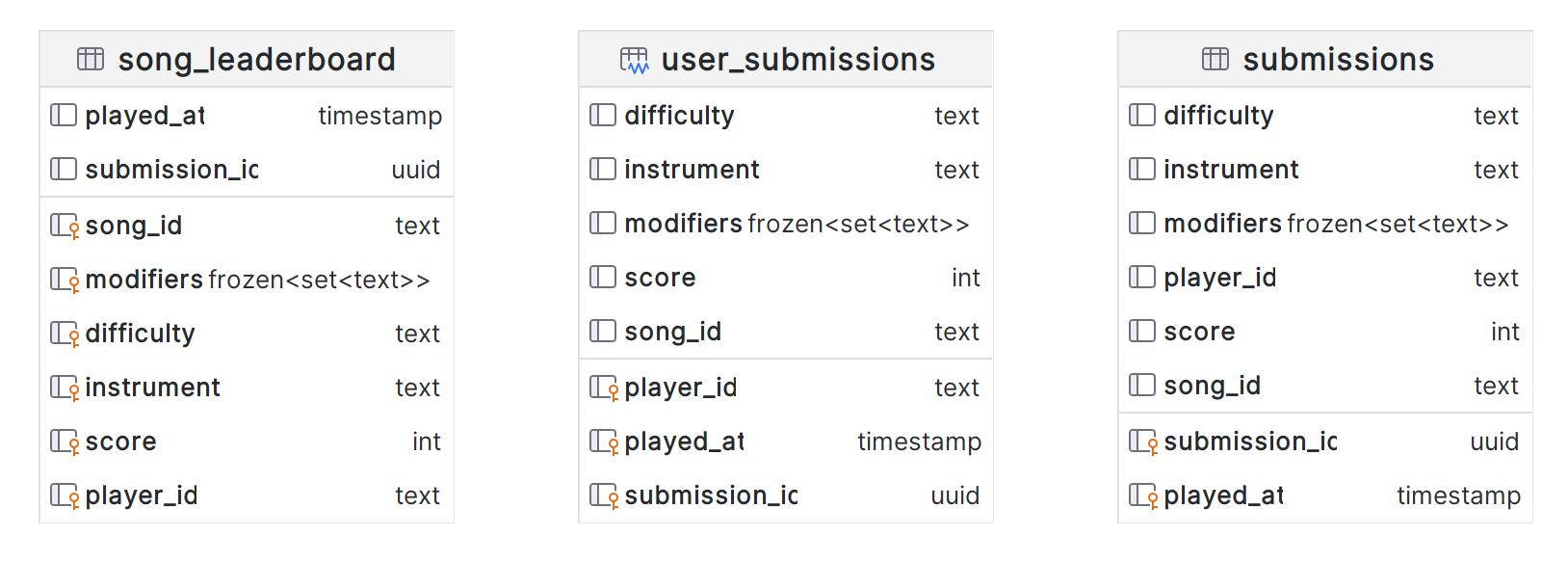Was this page helpful?
Design and Data Model¶
You can learn more about Data Modeling in Scylla (and NoSQL) by taking this course on Scylla University. The main goal of data modeling in Scylla is to perform queries fast, even if we sometimes have to duplicate data.
Let’s build our schema around the queries we are going to run against our domain entities. When creating the data model, you need to consider both the conceptual data model and the application workflow: which queries will be performed by which users and how often.
To achieve that, we want:
Even data distribution
To minimize the number of partitions accessed in a read query.
On the other hand, our focus won’t be on avoiding data duplication or minimizing the number of writes. You’re probably familiar with the steps defined here:
Conceptual Data Model¶
Starting with the conceptual data model, we need to identify the key entities and the relationships between them. Our application will be focused on three different entities, such as:
Song Submission - Whenever a user finish a gameplay and submit it to general submissions.
Players Submissions - Store the latest gameplays and scores from a specific user.
Song Leaderboard - Leaderboard based on specific song, instrument, difficulty and modifiers.
The concept is to fill with many songs as we want.

Application Workflow¶
Next, we move on to the Application Workflow. In this part, we identify the main queries or what questions we will ask the database. This part is important in Scylla and other NoSQL databases and, as opposed to relational databases is performed early on in the data modeling process. Remember that our data modeling is built around the queries.
Application Features¶
Insert Submission
Find a Submission
List the Player’s Last Submissions
Song Leaderboard
Queries¶
Now we can detail the above queries in CQL:
Q1: Create a Keyspace
CREATE KEYSPACE leaderboard
WITH replication = {'class': 'NetworkTopologyStrategy', 'replication_factor': '3'}
AND durable_writes = true;
Q2: Create the ‘Submissions’ Table
CREATE TABLE IF NOT EXISTS leaderboard.submissions (
submission_id uuid,
song_id text,
player_id text,
modifiers frozen<set<text>>,
score int,
difficulty text,
instrument text,
played_at timestamp,
PRIMARY KEY (submission_id, played_at)
);
Q3: Create the ‘Leaderboard’ Table
CREATE TABLE IF NOT EXISTS leaderboard.song_leaderboard (
submission_id uuid,
song_id text,
player_id text,
modifiers frozen<set<text>>,
score int,
difficulty text,
instrument text,
played_at timestamp,
PRIMARY KEY ((song_id, modifiers, difficulty, instrument), score, player_id)
) WITH CLUSTERING ORDER BY (score DESC, player_id ASC);
Q4: Create the ‘User Submission History’ Materialized View
CREATE MATERIALIZED VIEW leaderboard.user_submissions AS
SELECT *
FROM leaderboard.submissions
WHERE
submission_id IS NOT null AND
player_id IS NOT null AND
played_at IS NOT null
PRIMARY KEY ((player_id), played_at, submission_id)
WITH CLUSTERING ORDER BY (played_at DESC);
Q5: Insert new ‘Submission’ and ‘Leaderboard’
INSERT INTO leaderboard.submissions (
submission_id, song_id, player_id, modifiers, score, difficulty, instrument, played_at
) VALUES (
b5ee3f80-40f9-4dfd-9fb6-13a6c94147a3, 'starlight-muse', 'daniel-reis', {'none'}, 1000, 'expert', 'guitar', '2023-11-23 00:00:00'
);
INSERT INTO leaderboard.song_leaderboard (
submission_id, song_id, player_id, modifiers, score, difficulty, instrument, played_at
) VALUES (
b5ee3f80-40f9-4dfd-9fb6-13a6c94147a3, 'starlight-muse', 'daniel-reis', {'none'}, 1000, 'expert', 'guitar', '2023-11-23 00:00:00'
);
Note
Since both tables have the same structure, the query will be same changing only the table name. For each new Submission the same data should be added to Leaderboard;
Q6: Search a specific Submission
SELECT * FROM submissions WHERE submission_id = b5ee3f80-40f9-4dfd-9fb6-13a6c94147a3
Q7: Search a specific Song leaderboard
SELECT * FROM leaderboard.song_leaderboard
WHERE
song_id = 'starlight-muse'
AND modifiers = {'none'}
AND difficulty = 'expert'
AND instrument = 'guitar'
AND player_id = 'danielhe4rt'
LIMIT 10;
Q8: Retrieve User Submission History
SELECT * FROM leaderboard.user_submissions WHERE
user_id = 'daniel-reis'
LIMIT 10;
Q9: Delete outdated leaderboard score from a user.
DELETE FROM leaderboard.song_leaderboard
WHERE
song_id = 'starlight-muse'
AND modifiers = {'none'}
AND difficulty = 'expert'
AND instrument = 'guitar'
AND player_id = 'daniel-reis'
AND score < 1000;
Note
If the user submit the same song with a higher score, you should delete the previous leaderboard entry and add the new one.
Helpful Material¶
Some more advanced topics not covered in this guide are Collections, User-DefinedTypes (UDT), expiring data with time to live (TTL), and Counters.
To summarize, when data modeling with Scylla, we have to know our data, think about our queries, pay attention to the primary key and clustering key selection, and not be afraid to duplicate data.
